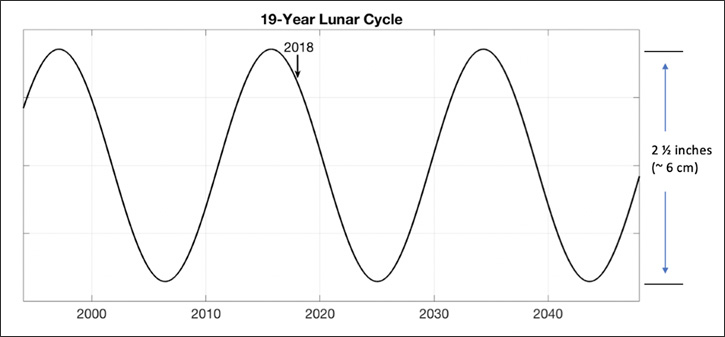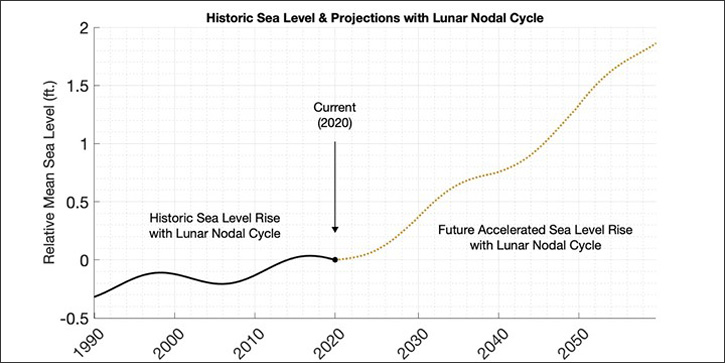LUNAR CYCLE TO CREATE MORE CONFUSION (page 48 in Moving to Higher Ground, © John Englander, 2021)
Most people are aware that the gravitational pull of the moon and sun on our oceans is the basic force causing the daily change of ocean height we refer to as tides. When the sun and moon are in alignment and pulling together, during a new or full moon, the force is greatest and the tides are highest. These are sometimes referred to as spring tides, though they have no relation to the season.
Four times a year, when the moon is closest to Earth and happens to coincide with one of those spring tides, the high tides become extra high. Properly called a “perigean high tide,” they are more commonly referred to as “king tides.”
In coastal areas all over the world, SLR has increased the flooding from king tides, creating ocean heights higher than at any previous time in human civilization, with the exception of short-term weather events like storms and high winds.
Now consider another natural phenomenon. About every 19 years, a lunar nodal cycle begins. This little-known occurrence was first documented by the Greek astronomer Meton of Athens almost 2,500 years ago in 432 BC. (In fact, the Meton cycle is incorporated into the Greek, Chinese, and Hebrew calendars and is still used to set the dates for events like Easter.)
Each up-cycle and each down-cycle lasts about 9.5 years, and changes sea level about 2.5 inches (6 cm). In other words, during each half of the 19-year period, this particular cycle will either add to peak high tide or subtract from it.

Figure 7: The 19-year repeating pattern of adjustments to high and low tides occurs because of the different angles and strengths of the sun and moon pulling on the oceans. Though only creating a 2.5 inch (~ 6 cm) variation in SLR, it adds a surprising element of confusion to discussions about sea level
Presently, the global average rate of real SLR due to increasing ocean water volume is almost 2 inches (5 cm) per decade. During the most recent up phase of the lunar nodal cycle, from 2007 – 2015, the 2.5 inches from this tidal cycle added to the roughly 2 inches of global average SLR, causing roughly 4.5 inches of combined higher sea level at peak high tide. This accounts for the seemingly extremely high rate of SLR in the period ending around 2015.
In 2018, we started a down phase of the 19-year cycle. Global sea level will still go up another 2 inches, largely from the melting ice. But the 19-year lunar cycle has reversed and will subtract 2.5 inches from sea level over these nine years, effectively nullifying apparent SLR. This creates an impression that SLR is slowing, which may confuse or even falsely be used as support for those that do not believe in climate change.

Figure 8: The graph overlays the 19-year cycle combined with SLR.
In the next up phase of the lunar cycle, which will occur from 2025–2034, it will very likely again appear as if sea levels have risen four or five inches in a decade, understandably causing confusion and surprising many. Figure 8 combines the lunar nodal cycle with projections for rising sea level. Though subtle, note how the slope of the line changes. Few appreciate how the roughly nineteen year pattern of tides identified thousands of years ago, adds to the confusion about rising sea level in the modern era.